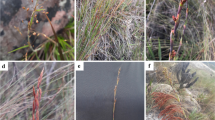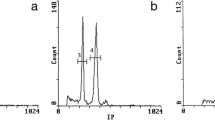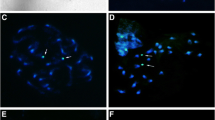Abstract
Genome analysis has been used to investigate the evolutionary relationships of the tetraploid species in the genus Cochlearia. The results indicate that both C. officinalis L. (2n=24) and C. micacea Marshal (2n=26) are essentially autotetraploid in origin and that C. scotica Druce is simply a morphological variant of C. officinalis. The chromosomal relationships of the tetraploids to each other and to the diploids in the genus are discussed and the possible routes for the formation of all the species from a single, 2n=12, basic taxon are given. Evidence for the existence of a genic mechanism causing C. officinalis to form only bivalents is given and the mode of evolution of such a mechanism discussed.
Similar content being viewed by others

References
Chater, A. D. & V. H. Heywood (1964). In: T. G. Tutin et al., Flora Europae-I. Cambridge Univ. Press.
Clapham, A. R. (1952). In: A. R. Clapham et al., Flora of the British Isles. Cambridge Univ. Press.
Crane M. B. & A. E. Gairdner (1923). Species crosses in Cochlearia with a preliminary account of their cytology. J. Gen. 13: 187–200.
Darlington C. D. (1965). Cytology. Churchill, London.
Dewey D. R. & P. G. Pendse (1967). Cytogenetics of crested wheatgrass triploids. Crop Sci. 7: 345–349.
Gill J. J. B. (1971a). Cytogenetic studies in Cochlearia L. The chromosomal homogeneity within both the 2n=12 diploids and the 2n=14 diploids and the cytogenetic relationship between the two chromosome levels. Ann. Bot. 35: 947–956.
Gill J. J. B. (1971b). The cytology and transmission of accessory chromosomes in Cochlearia pyrenaica DC. (Cruciferae). Caryologia 24: 173–181.
Gill J. J. B. (1971c). Cochlearia scotica Druce — Does it exist in northern Scotland? Watsonia 8: 395–396.
Hylander, N. (1945). Nomenklatorische und systematische Studien über nordische Gefässpflanzen: Uppsala und Leipzig.
Lovkvist B. (1963a). Taxonomic problems in aneuploid complexes. Regnum veg. 27: 51–57.
Lovkvist B. (1963b). Nagot om de skanska Cochlearia arterna. Bot. notiser 116: 326–330.
Marshall E. S. (1894). On an apparently undescribed Cochlearia from Scotland. J. Bot. Lond. 32: 289–292.
Mosquin T. (1967). Evidence for autopolyploidy in Epilobium angustifolium (Onagraceae). Evolution 21: 713–719.
Riley R. (1960). The diploidisation of polyploid wheat. Heredity, Lond. 15: 407–429.
Saunte L. H. (1955). Cytogenetical studies in the Cochlearia officinalis complex. Hereditas 41: 499–515.
Sörensen, T. & M. Westergaard (1948). In: A. Löve & D. Löve, Chromosome numbers of Northern plant species. Icel. Univ. Inst. Appl. Sci. Dept. Agric. Rep. B. 3: 1–131.
Vasek F. C. (1956). Induced aneuploidy in Clarkia. Am. J. Bot. 43: 366–371.
Author information
Authors and Affiliations
Rights and permissions
About this article
Cite this article
Gill, J.J.B. Cytogenetic studies in Cochlearia L. (Cruciferae). The origins of C. officinalis L. and C. micacea Marshall. Genetica 44, 217–234 (1973). https://doi.org/10.1007/BF00119107
Received:
Accepted:
Issue Date:
DOI: https://doi.org/10.1007/BF00119107



